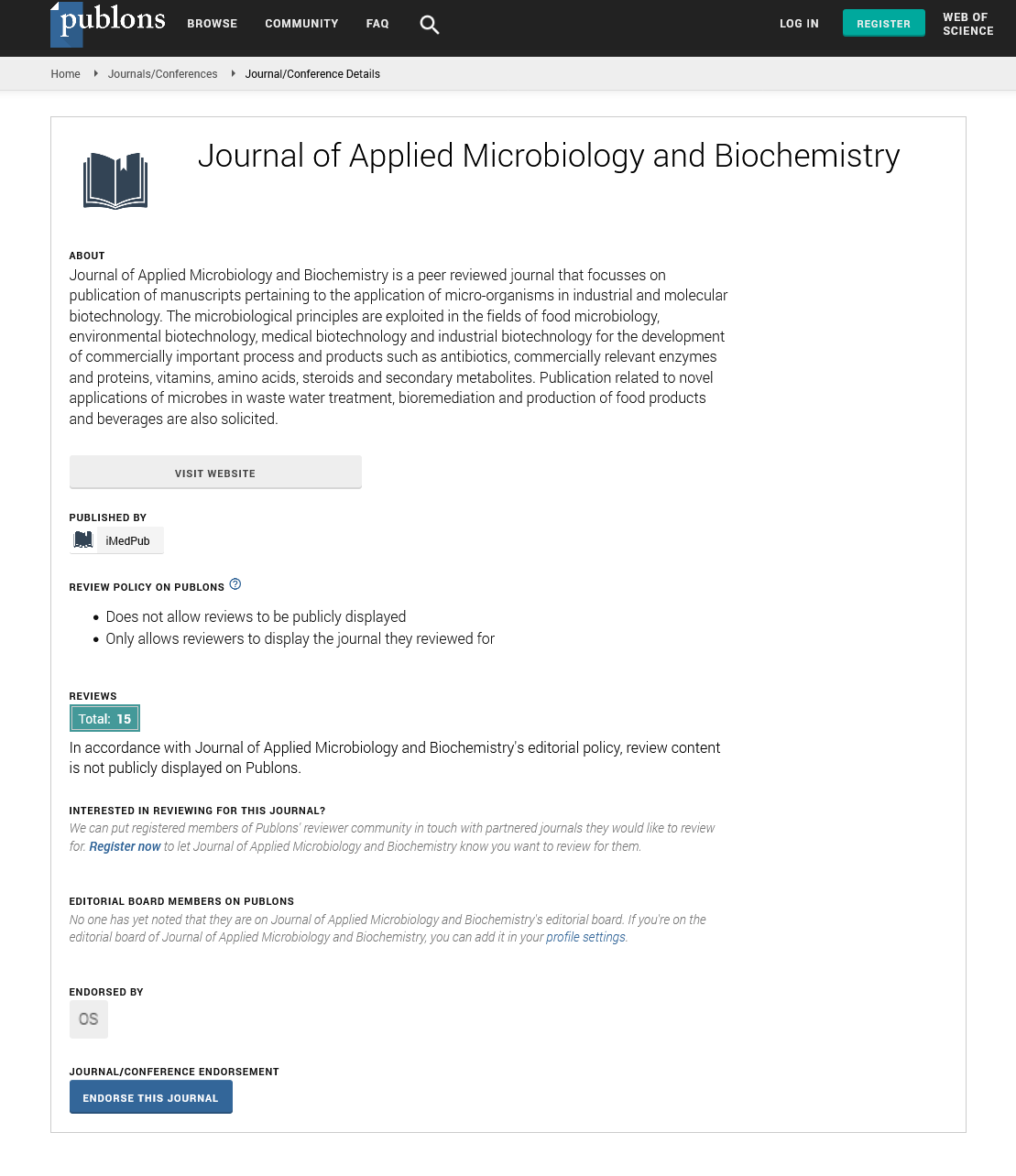ISSN : ISSN: 2576-1412
Journal of Applied Microbiology and Biochemistry
Abstract
Euro Virology Influenza 2018: Pinosylvin decreases matrix metalloproteinase-2 expression and suppress oral cancer cell invasion and migration- Mu Kuan Chen- Christian Hospital
Oral squamous cell carcinoma (OSCC) is the most common primary malignancy occurring in the head and neck. It is the fourth most common male cancer and the fourth leading cause of male cancer death in Taiwan. Metastatic tumors are extremely common in the late stages of cancer. Treatment for metastatic cancer aims to decelerate the growth or spread of cancer. The extracellular matrix degradation involves various proteases such as matrix metalloproteinase (MMPs), are calcium-dependent zinc-containing endopeptidases. MMP-2 is type-IV collagenases of MMPs, and correlated with lymph node metastasis and advanced tumor stage groups. Pinosylvin, a preinfectious stilbenoid toxin, is used to study its properties as a fungi toxin and therapeutic agent. Pinosylvin is used as a representative stilbene to study its biological actions and therapeutic value in processes such as cell survival, apoptosis and cell mobility. However, the pharmacological activities of pinosylvin in anti-metastasis remain unclear. In this study, we used wound closure assay and transwell assay to determine the effects of pinosylvin on oral cancer cell migration and invasion. Pinosylvin treatment significantly inhibited the migration and invasion abilities of oral cancer cells in vitro. Gelatin zymography results revealed that pinosylvin inhibited MMP-2 activity. In addition, pinosylvin suppressed carcinoma-associated epithelial–mesenchymal transition in oral cancer cells. Pinosylvin inhibits the invasion of human oral cancer cells and is a potential chemopreventive agent against oral cancer metastasis.
0ne kind of naturally trans-stilbenoid, pinosylvin (3,5-dihydroxy-trans-stilbene), a occurring found in heartwoods and leaves of Pinus sylvestris. Pinus is rich in phenolic compounds and possesses anti-inflammatory, antitumor, and antioxidant properties . Pinosylvin produces phytoalexins through a reaction between cinnamoyl-CoA and malonyl-CoA under the influence of ultraviolet light, ozone, and fungi . The polyphenol pinosylvin is a secondary plant metabolite that protects against microbes and insects . In addition, pinosylvin regulates growth inhibition and apoptosis in cancer cells by regulating NAG-1 overexpression . Eun et al. found that pinosylvin suppressed the expression of MMP-2 and MMP-9 and reduce the migration ability in human fibrosarcoma cells . Subsequently, Eun et al. reported that pinosylvin exerted an antiproliferative effect on human colorectal HCT116 cancer cells through the glycogen synthase kinase-3/β-catenin and Src/extracellular signal-regulated kinase signaling pathway .
Oral squamous cell carcinoma (OSCC) is a fatal cancer that easily metastasizes to other organs of the body. Lymph node metastasis and a high recurrence rate are the causes of high mortality from OSCC. In addition, tobacco smoking and alcohol consumption are strongly linked to oral cancer [9]. Although surgery, radiation, and chemotherapy are the main treatment options for OSCC, the choice of treatment depends on the cancer stage. However, the survival of patients with OSCC remains impoverished even after treatment. Thus, understanding molecular mechanisms that mediate OSCC migration and invasion might facilitate the prevention of OSCC recurrence.
Cancer metastasis is a perplexed cellular course that involves invasion of local tumor cells; entry of tumor cells into blood circulation, followed by the exit of cancer cells from blood circulation; and colonization of tumor cells at distant sites ]. The extracellular matrix (ECM) is highly dynamic and participates in various cell behaviors, including cell adhesion, invasion/migration, proliferation, differentiation, and death . Zinc-dependent MMPs may participate in ECM degradation and play a key role in tumor growth and cancer metastasis and invasion . MMP-2 and MMP-9 have been used as crucial targeting agents in oral cancer, osteosarcoma, and nasopharyngeal carcinoma to regulate tumor metastasis . In addition, tissue inhibitors of metalloproteinases (TIMPs) are related to the regulation of MMPs and are considered to be a specific endogenous inhibitor of MMPs . Similar to metalloproteinases, TIMPs are involved in cell growth, differentiation, and migration and demonstrate antiangiogenesis, antiapoptosis, and proapoptosis properties . Chang et al. reported that EGCG significantly increased the expression of TIMP-2 in M17 cells and also reduced the expression of MMP-2 upon that inhibited the migration of human uveal melanoma cells . However, the effect of pinosylvin on human OSCC metastasis remains unclear. Therefore, the present study investigated the effects of pinosylvin on the migration/invasion ability of human oral cancer cells in vitro and evaluated the signaling pathway involved in this process.
Note:This work is partly presented at Joint Event 10th International Virology Summit & 4th International Conference on Influenza & Zoonotic Diseases July 02-04, 2018 at Vienna, Austria
Author(s): Mu Kuan Chen
Abstract | PDF
Share This Article
Google Scholar citation report
Citations : 342
Journal of Applied Microbiology and Biochemistry received 342 citations as per Google Scholar report
Journal of Applied Microbiology and Biochemistry peer review process verified at publons
Abstracted/Indexed in
- Google Scholar
- China National Knowledge Infrastructure (CNKI)
- Cosmos IF
- Directory of Research Journal Indexing (DRJI)
- Publons
- Secret Search Engine Labs
Open Access Journals
- Aquaculture & Veterinary Science
- Chemistry & Chemical Sciences
- Clinical Sciences
- Engineering
- General Science
- Genetics & Molecular Biology
- Health Care & Nursing
- Immunology & Microbiology
- Materials Science
- Mathematics & Physics
- Medical Sciences
- Neurology & Psychiatry
- Oncology & Cancer Science
- Pharmaceutical Sciences
